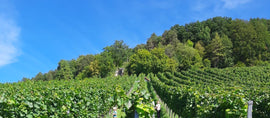Tuscany may draw more tourists, but Emilia-Romagna, its neighbor to the north, mounts a mosaic of Italian cultural splendor everywhere you look. Stretching across north-central Italy, from the southeastern tip of Piedmont to the Adriatic Sea, the nine provinces that make up the region flaunt apogees in everything from cars (Ducati, Lamborghini, Ferrari, Maserati, and Pagani all rev their engines here); to cinema (Antonioni, Bertolucci, Pasolini, and Fellini are native sons; the latter’s immortal Amacord was filmed in his childhood home of Rimini on the Adriatic); to music (composers Verdi and Toscanini hail from the small town of Busseto and the City of Parma, respectively); to, of course, mosaics (the stunning early Christian art of one time Roman Empire capital Ravenna).
It’s an amazing place to venerate the heights of human craft and creativity - and then go eat, because Emilia-Romagna is also the food capital of Italy. Parma, the region’s second largest city is the birthplace of both Parmesan Reggiano and Prosciutto di Parma; Bologna, the actual capital and largest city - which also houses the world’s oldest university - gifts the world ragù (bolognese sauce) and tagliatelle. Modena, hometown of the tenor Pavoratti, is also responsible for balsamic vinaigrette in its most elevated form. Nor is the region simply coasting on its culinary past – Osteria Francescana* in Modena, topped the ‘World 50 Best Restaurants’ list in 2016 and 2018 - and there are countless exceptional places to eat that are less famous and easier to get into.
The wine is great too of course, though sometimes it gets eclipsed by all the blinding excellence nearby. Viticulture in Emilia-Romagna is quite regionally specific and has developed roughly along the bifurcation traced by its hyphen. Emilia, the western part, which consists of the provinces of Piacenza, Parma, Reggio Emilia, Modena, and Ferrara, was settled by historically Barbarian populations, whose rich diet of butter and pork called for the palate cleansing properties of sparkling wine. Consequently, this is where Lambrusco, the sparkling red that is the region’s best known (and one of Italy’s oldest) wines, comes from. Romagna, made up of Ravenna, Forlì-Cesena, and Rimini in the east, was ruled by Romans and olive oil whose herb-y, oleaginous effect requires wine with more structure to balance the flavors in the mouth. Romagna is best known for the thick-skinned white grape Albana, whose roots in the region go back to antiquity (Albus = white in Latin) and is rarely seen outside it; and Sangiovese di Romagna, the local variation on the iconic red grape best known for Tuscan bottlings like Chianti and Brunello.
This month, for the first time ever in the club, we have two sparkling selections, both from the aforementioned Emilia side of the divide. Some of you will inevitably find this detour more welcome than others, but there is just no way to do justice to Italian wine without covering the bubbles at some point. Plus, our producers here are both multi-generational frizzante 4 life families devoted to crafting world class effervescence via a doggedly local focus.
Salut,
Alan Hicks - Wine Buyer - Noe Valley
*The by the glass list there features 3 bottlings by Cantina della Volta.
|
Donati Malvasia dell’Emilia Frizzante Secco 2023 |
|
|
Region: Vino Bianca, Emilia Romagna |
About the Winery: The Donati estate was started in 1930 and now run by its third generation-- Camillo, his wife and their children. They cultivate 11.5 hectares of vines (7.5 of which they own as Tenuta S. Andrea and four which are leased at Tenuta Bottazza) using organic and biodynamic practices. They are about 20 km away from Parma in the hillside at an altitude of around 250m with an eastern exposition. The Malvasia di Candia is historically from Crete, arriving in this part of Italy many centuries ago, and it is also one of the oldest known grapes. Up until 30-50 years ago, it was only vinified in sweet and demi-sec style, but Donati now makes both a dry and sweet Malvasia. About the Winemaking: All the grapes, including the white, are fermented like red wines (with skin contact), without temperature control, native yeasts, no fining, no acidification or de-acidification, no added Sulfur, etc. The carbonation of these frizzante wines comes from the traditional method of refermentation in bottle, a method that does not require preservatives and which makes this wine, unlike those produced in charmat method, age better. The wines are not filtered and are topped with a crown cap, a traditional closure for some decades in this region. There may be resulting sediment and the bottles should be poured somewhat carefully without a lot of intense movement. 100% Malvasia di Candia from biodynamically cultivated ~24 year-old vines planted to the clay soils of Via Costa in central-western Emilia-Romagna. Short maceration/spontaneous fermentation in stainless steel prior pressing and bottling a la ancestral method unfined, unfiltered, no additional SO2. Tasting Notes: Peach, green apple and pear notes on the nose, lead to a palate defined by marmalade and apricot notes with herbal accents, fine bubbles and a snappy salinity on the finish. |
|
Winemaker: Camillo Donati & family |
|
|
Price per bottle / Price per case $24.99/$329.86 |
|
|
Suggested Food Pairing: Grilled calamari with lemon and herbs fresh burrata with prosciutto di Parma Asparagus Risotto Seafood Pasta Vegetable Tempura |
|
|
Cantina della Volta Brut Rosso |
|
|
Region: Lambrusco di Sorbara DOC |
About the Winery: Cantina della Volta is the result of one hundred years of experience of the Bellei family, winemakers from Bomporto di Modena since 1920, of which the oenologist Christian is from the fourth generation of experience of the Bellei family, winemakers from Bomporto di Modena since 1920, of which the oenologist Christian is from the fourth generation. Despite the winery being in the heart of Lambrusco di Sorbara territory, Christian and his father Giuseppe have always nurtured a great passion for sparkling wines of the finest quality. After making numerous visits to Epernay, the capital of Champagne, to study the winemaking processes with the Traditional Method, they then applied it to the grapes in their own winery in Bomporto. This great passion for the Traditional Method led Christian Bellei to found the Cantina della Volta in 2010. The company is based in the original building of the Cantina Bellei, built by Christian’s great-grandfather on the banks of the Naviglio di Bomporto canal, near the 18th-century dock, where boats would perform la volta (‘the turnaround’) before setting sail once more to return back to the city of Modena. It is to this place, steeped in meaning and history, that we owe the symbol of the riverboat and the company name of the Cantina della Volta. About Winemaking: Harvested in the last week of September, Lambrusco di Sorbara Spumante D.O.C. is obtained from the single variety vinification of the best Lambrusco di Sorbara grapes. The wine undergoes the secondary fermentation in the bottle, sticking to the Classic Method procedure. Bottles are then stored horizontally at a constant room temperature of 12°C for at least nine months. After the rémuage and the disgorgement, liqueur d’expédition is added, then bottles are corked, wired and labeled. Tasting Notes: Brilliant ruby red color, with elegant and uninterrupted chains of tiny perlage, characteristic of the Classic Method. On the nose, inviting fragrances of raspberries and juicy wild strawberries mixed with intriguing citrus notes. On the palate, it begins true to the character of Sorbara, then unfolds into rich, fruity flavors. Nice finish, good persistence, excellent harmony in the balance of acid and salty flavors. Clean finish. |
|
Winemaker: Christian Bellei |
|
|
Price per bottle / Price per case $29.99 $323.90 |
|
|
Suggested Food Pairing: Local fare like salami, prosciutto, mortadella, bresaola Bolognese Ragù, tortellini, ravioli, cannelloni e pizza. But also spicy dishes of all kinds and even dark chocolate. |
|
(Quick) Tortellini in Brodo
Making tortellini from scratch is a family holiday tradition in Italy, but since you don’t always have the time or the numbers to make that happen, here is a quick way to enjoy a classic Lambrusco pairing. This one is vegetarian but pork is the traditional meat filling for the tortellini here.
Ingredients
1 Tbsp. olive oil
2 cloves garlic, thinly sliced
1/8 tsp. red pepper flakes
6 cups (1 1/2 cartons, 32 oz. each) vegetable broth
1 pkg. (9 oz.) refrigerated cheese tortellini
1 pkg. (5 oz.) baby spinach leaves (about 5 cups packed)
2 Tbsp. thinly sliced fresh basil
1 Tbsp. fresh lemon juice
1/2 tsp. grated lemon zest
Shredded Parmesan cheese, optional
Instructions
-
Heat oil in a 5 to 6-qt. saucepan or Dutch oven over medium heat; add garlic and red pepper flakes and cook 30 to 45 seconds, just until the garlic is lightly toasted. Remove pan from heat and slowly stir in broth.
-
Return pan to heat. Bring broth to a boil over high heat; add tortellini. Reduce heat to medium; cover and simmer 1 minute less than recommended on tortellini package.
-
Stir in spinach, basil, lemon juice and zest; cook about 1 minute or just until spinach is wilted. Serve immediately with additional basil and shredded Parmesan cheese, if desired.





